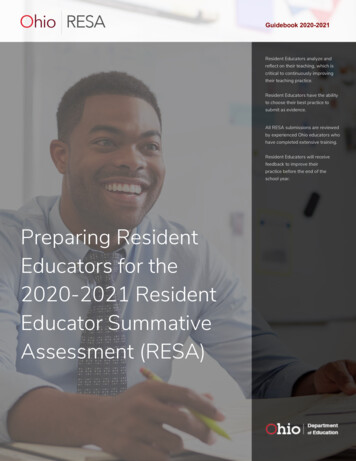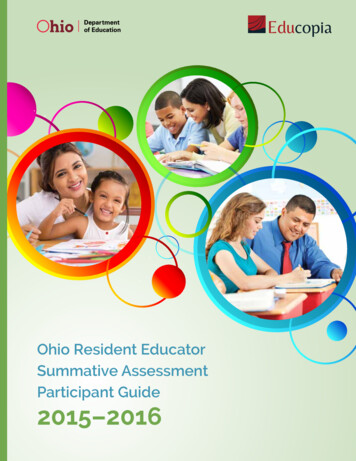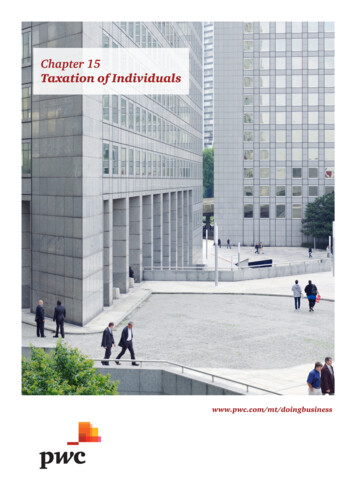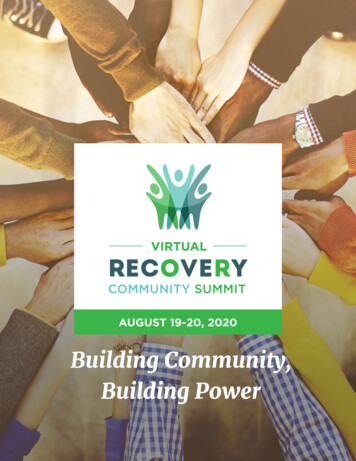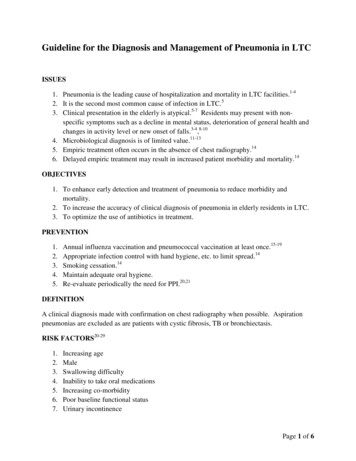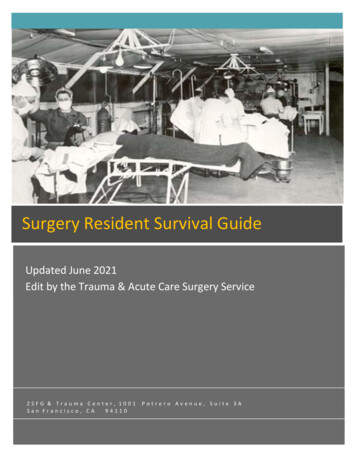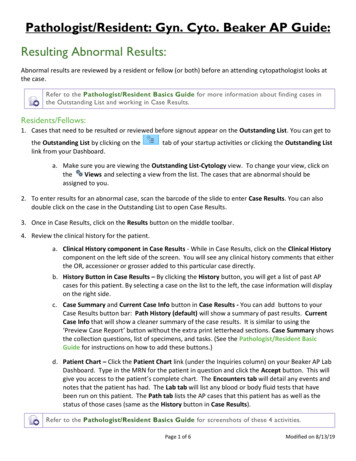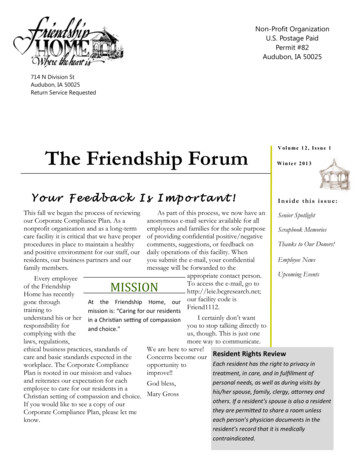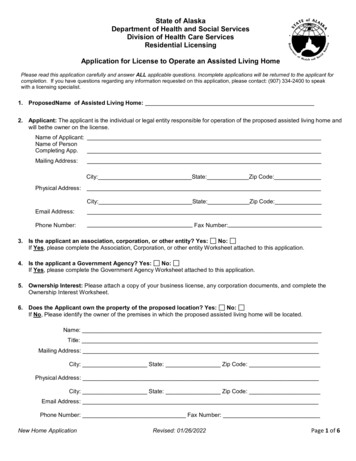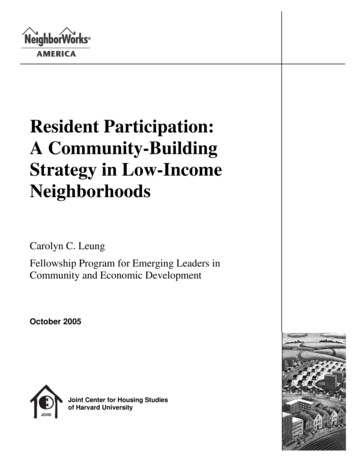
Transcription
Resident Participation:A Community-BuildingStrategy in Low-IncomeNeighborhoodsCarolyn C. LeungFellowship Program for Emerging Leaders inCommunity and Economic DevelopmentOctober 2005Joint Center for Housing Studiesof Harvard University
Resident Participation: A Community-Building Strategy in Low-Income NeighborhoodsNEIGHBORWORKS AMERICANeighborhood Reinvestment Corporation dba NeighborWorks America was established by an Act ofCongress in 1978 (Public Law 95-557). A primary objective of the Corporation is to increase thecapacity of local, community-based organizations to revitalize their communities, particularly byexpanding and improving housing opportunities.These local organizations, known as NeighborWorks organizations, are independent, resident-led,nonprofit partnerships that include business leaders and government officials. All together they makeup the NeighborWorks network.JOINT CENTER FOR HOUSING STUDIES OF HARVARD UNIVERSITYThe Joint Center for Housing Studies analyzes the ways in which housing policy and practices areshaped by economic and demographic trends, and provides leaders in government, business and thenonprofit sector with knowledge and tools for formulating effective policies and strategies.Established in 1959, the Joint Center is a collaborative unit affiliated with the Harvard Design Schooland the Kennedy School of Government at Harvard. The Center’s programs of research, educationand public outreach inform debate on critical housing issues and illuminate the role of housing inshaping communities. The Policy Advisory Board, a diverse group of business leaders in the housingsector, provides support and guidance for the Center and its activities. The Joint Center also receivesinput from its Faculty Committee, which draws on the expertise of a university-wide group ofscholars.This paper was written with the support of the NeighborWorks America’s Emerging Leaders inCommunity and Economic Development Fellowship, which provides opportunities for highlyqualified professional students at Harvard University to research and publish applied analyticalprojects of interest to the community-development field.The opinions expressed represent solely the opinions of the author, not those of NeighborWorks America, the Joint Center for Housing Studies of Harvard University, or of any of the persons,entities or organizations providing support to, or affiliated with, these entities. The findings andconclusion of this report are solely the responsibility of the author.This analysis was performed with the support of NeighborWorks America, with editing andproduction by Amy Christian, Ampersand Editing & Production Services. The Corporation has fullrights to use and distribute this document.Copyright 2005 by Carolyn C. Leung.Harvard Joint Center for Housing StudiesHarvard University1033 Massachusetts Avenue, 5th FloorCambridge, MA 02138(617) 495-7908www.jchs.harvard.eduOctober 2005NeighborWorks America1325 G Street, NW, Suite 800Washington, DC 20005(202) 220-2300www.nw.orgi
Resident Participation: A Community-Building Strategy in Low-Income NeighborhoodsAbout the AuthorCarolyn C. Leung is a doctoral student at the Harvard Graduate School of Education. Herresearch interests focus on the experiences of scholars of color who pursue race-basedresearch for social justice. Carolyn has also been active in several nonprofits in the AsianAmerican community in San Francisco and Boston. Carolyn also has a masters in UrbanPlanning from the University of California, Los Angeles.iiOctober 2005
Resident Participation: A Community-Building Strategy in Low-Income NeighborhoodsAbstractResident participation has been an area of community development aimed at increasinginvolvement of tenants in housing development, management and community-building. Theprecise roles and mechanisms of resident participation are not well understood, however.This paper explores the role of resident participation and its interaction with other factors thatdrive community revitalization. By understanding the necessary conditions, factors and othervariables that strengthen resident participation, public policies can help low-income populations manifest their power and make a difference in their communities. The research presented here (1) describes the challenges and benefits of resident participation; (2) identifiesexamples of residents successfully contributing to the development and management of theirhomes; (3) details the conditions necessary for success; and (4) addresses the issue ofassessing effectiveness.For those seeking to encourage resident participation, the are three major challenges includetime and money; limited options due to economics; and limited community capacity.Examples of successful resident participation are presented, such as the DemonstrationDisposition in Boston — one of the most notable examples of resident participation indevelopment in the past 10 years. Building management has also been an arena for variouslevels and types of resident participation, and many community development corporationshave developed creative ways of involving residents in community-building efforts.The interplay of external and internal factors together creates conditions for residentparticipation. This paper identifies four major factors: impetus, politics, resources and values,describing the internal and external resources affected by each. To connect these external andinternal resources, bridging resources of trust, community organizing, strategic partnershipsand organizational capacity are necessary. Community planning and education make up anoteworthy bridging resource that allows for the necessary learning process to take place.Community education and planning happen in three phases: building a foundation, teachingskills, and following through.While there is general support for resident participation in housing development, management and community-building, measuring its effectiveness has received limited researchattention. This paper describes the effectiveness of resident participation looking at theindividual, building and community levels. These testimonials will be strengthened if hardmeasures of resident participation are developed and used to study its effects.October 2005iii
Resident Participation: A Community-Building Strategy in Low-Income NeighborhoodsTable of ContentsAbout the Author. iiAbstract. iiiExecutive Summary . 1Challenges and Benefits to Resident Participation . 1Examples of Successful Resident Participation. 1Conditions for Effective Resident Participation . 2Descriptions of Effectiveness . 2Methodology. 3I. Introduction . 4Research on Resident Participation . 4II. Benefits and Challenges of Resident Participation . 7Challenge One: Time and Money . 7Benefit: Customer satisfaction . 7Challenge Two: Limited Community Capacity. 8Benefit: Community knowledge . 8Challenge Three: Limited Options Due to Economics . 8Opportunity: Community organizing as a community-revitalization strategy. 9III. Examples of Successful Resident Participation . 10Resident Participation in Development . 10Resident Participation in Community-Building Efforts . 12IV. Conditions for Successful Resident Participation . 14Impetus. 14Politics. 15Values . 17Resources . 17Putting It All Together: Bridging Resources . 18Trust. 18Community Organizing. 19Strategic Partnerships . 19Organizational Capacity . 20Community Planning and Education. 20V. Describing the Effectiveness of Resident Participation . 24The Impact of Resident Participation in Development. 24The Impact of Resident Participation in Management . 24The Impact of Resident Participation in Community-Building. 25Selected Sources . 28Web Sites . 29Author Interviews. 30Acknowledgements . 32Collaborating Staff. 32Additional Reviewers and Contributors. 32ivOctober 2005
Resident Participation: A Community-Building Strategy in Low-Income NeighborhoodsExecutive SummaryResident participation has been an area of community development aimed at increasing involvement of tenants in housing development, management and community-building. Whileresident participation is not a blanket remedy for complex problems facing the affordablehousing community today, it is an important strategy for community development. The precise roles and mechanisms of resident participation are not well understood, however. Thispaper explores the role of resident participation and its interaction with other factors thatdrive community revitalization. By understanding the necessary conditions, factors and othervariables that strengthen resident participation, public policies can help low-income populations manifest their power and make a difference in their communities. The research presented here (1) describes the challenges and benefits of resident participation; (2) identifiesexamples of residents successfully contributing to the development and management of theirhomes; (3) details the conditions necessary for success; and (4) addresses the issue ofassessing effectiveness.Challenges and Benefits to Resident ParticipationResident participation has roots in both public-policy and grassroots community-organizingefforts. It invokes multiple meanings and includes such activities as coming to informationalmeetings about what’s going on in one’s building or being involved in decisions about thedesign and construction of one’s housing. For those seeking to encourage resident participation, there are three major challenges:Time and money: While there are costs of time and money associated with residentparticipation, over the long run resident participation can help to increase customersatisfaction. In development and management, it can also help to save money and timeover the long run.Limited options due to economics: While those who live in assisted, affordable andpublic housing face limited options, community organizing can be a strategy for broadercommunity revitalization.Limited community capacity: Too often, residents of low-income communities are seenas bundles of problems that need to be fixed. Residents, however, can bring a wealth ofcommunity knowledge and skills that are vital for efforts to revitalize communities.Examples of Successful Resident ParticipationThis section profiles case studies of resident participation, such as the Demonstration Disposition in Boston, one of the most notable examples of resident participation in developmentin the past 10 years. Building management has also been an arena for various levels andtypes of resident participation, and many community development corporations havedeveloped creative ways of involving residents in community-building efforts.October 20051
Resident Participation: A Community-Building Strategy in Low-Income NeighborhoodsConditions for Effective Resident ParticipationThe interplay of external and internal factors together creates conditions for resident participation. This paper identifies four major factors:Impetus: What are the initial conditions under which resident participation arises? Anexternal crisis often catalyzes resident participation. Residents’ commitment is needed tostart the process of resident participation.Politics: The external political environment often creates the context for resident partici-pation. Internally, leadership is needed to sustain the momentum of resident participation.Resources: Resources are necessary for sustaining resident participation. Funding fromoutside government and foundation sources can provide the necessary financial support.Building a strong organization of residents helps to nurture the resources that residentsthemselves bring.Values: For resident participation to be a reality, all stakeholders involved must value itas a necessary part of the process.To connect these external and internal resources, bridging resources of trust, communityorganizing, strategic partnerships and organizational capacity are necessary. Communityplanning and education make up a noteworthy bridging resource that allows for the necessarylearning process to take place. Community education and planning happen in three phases:building a foundation, teaching skills, and follow-through.Descriptions of EffectivenessFinally, this paper asks, given what we know about resident participation, how do wedescribe its effectiveness? While resident participation has been difficult to measure, thispaper describes the effectiveness of resident participation looking at criteria at the levels ofthe individual, building and community.2October 2005
Resident Participation: A Community-Building Strategy in Low-Income NeighborhoodsMethodologyResearch for this paper developed in several stages. The first stage involved a literaturereview to understand the idea of resident participation as it has played out in public policyand in practice. The second stage — data collection — involved structured interviews with15 key informants in the field of housing, at the local, state and national levels. These conversations contributed data which provides a description of the depth and scope of residentparticipation. The next stage of this research sought to probe more deeply into specificexperiences with resident participation from the perspective of community developmentcorporations (CDCs). This process involved interviewing 10 staff of CDCs to understandtheir experience with resident participation. It also included interviews with several residentsof properties owned and/or managed by these CDCs. The goal of these interviews was todescribe the multiple ways in which CDCs are involved in resident participation. Aftercollecting data from these interviews, the analysis developed common themes and lessonslearned from policymakers and practitioners, and residents’ experiences with tenanteducation.It should be noted that due to time and travel constraints, this paper focuses primarily onresidents who are inhabitants of assisted, affordable or public housing in major urban areas,including Boston; Washington, D.C.; and Gilroy, San Diego and Sacramento, California.These findings may be less relevant to nonurban areas, or communities outside the East orWest Coasts.October 20053
Resident Participation: A Community-Building Strategy in Low-Income NeighborhoodsI. IntroductionResident participation, including activities such as meeting with developers to provide inputon design, serving on boards responsible for managing property, and working with neighborson policing or maintaining property, has been seen as an important strategy for the preservation of affordable housing. The thinking behind resident participation is that through participation, residents will have a greater stake in the property in which they live. Because of thisinvestment, they will take a more active role in preserving the quality of life at the site. Notonly will they devote greater attention to taking care of the property, they will also contributeto improving the overall life of the community, such as participating in public safety.Through their participation, residents may gain skills that help them in other areas of theirlife, such as education and employment opportunities. This can then potentially lead to selfsufficiency (Gray 2000).The genesis of resident participation was in the antipoverty programs that called for “maximum feasible participation” of citizens in community-revitalization efforts. Over the last 20years, two of the most significant pieces of legislation to promote resident participation inhousing include the Housing and Community Development Act of 1987 and the HOPE VIprogram. According to Chandler (1991), “The enactment of the Housing and CommunityDevelopment Act of 1987 solidified the emergence of resident management as the majoralternative to conventional management of public housing developments. The act gives resident management statutory standing and financial support and provides for the conversion ofpublic housing units to low-income ownership through resident management organizations”(p. 136). Almost 10 years later, the Multifamily Assisted Housing Reform and AffordabilityAct of 1997 continued to include tenant participation as part of the restructuring process.Specifically, tenants are to be involved in the mortgage restructuring and rental assistancesufficiency plans, proposed transfer of the project, and rental assistance assessment plans.In 1992 HOPE VI (also known as the Urban Revitalization Demonstration) attempted totransform the landscape of public housing. The goals of HOPE VI were threefold: to transform the dilapidated structures that much public housing had deteriorated into; to increaseresident self-sufficiency; and to promote a sense of community-mindedness among residents.The HOPE VI housing legislation required resident involvement in the design of the fundingrequest, resident training, and implementation and monitoring.Research on Resident ParticipationResident participation has not been extensively analyzed by researchers, but a few studieshave examined its effects. One area that has received considerable attention in the literatureis that of resident management. Resident participation in management has been used as analternative to management by the public housing authority. The focus on resident management started in the 1970s in Boston and St. Louis. Chandler (1991) conducted a review of theliterature and found that resident management councils “produce greater degrees of residentsatisfaction and more employment opportunities, reduce the incidence of social problems, allow for a higher degree of resident involvement and cost more than conventionalmanagement to operate” (p. 141). Monti (1993) studied resident management corporations(RMCs) and found that “a good RMC likely will be viewed as doing more on the site and4October 2005
Resident Participation: A Community-Building Strategy in Low-Income Neighborhoodsbeing stricter than the local housing authority. People also will say they generally have moreknowledge of what occurs on the site because of information coming from the tenant organization” (p. 192). One challenge that Monti found was that “their degree of involvement maynot be sustained over long periods of time” (p.192). At the time of Monti’s study, there werefewer than a dozen resident management corporations. Manpower Demonstration andResearch Corporation (1981) conducted a longitudinal study of tenant management of publichousing buildings and found that tenant management performed as well as the managementof the local housing authority.Peterman (1994, 1996) cautions, however, against a blind acceptance of resident participationin management. First, he argues that resident management should not be a substitute forfederal government support for public housing. He cautions that, “As a public policy, it hasbecome entangled with conservative ideology that promotes less government, more homeownership, and less public housing — goals that are likely to benefit few, if any, low-incomepublic housing residents” (Peterman 1994, p. 15). Second, he argues that resident participation does not necessarily lead to empowerment. He argues, “The deciding factor shouldalways be whether management provides the basis for a livable, healthy community” (Peterman 1996, p. 486). In conclusion, he advocates that resident management should not alwaysbe the goal of public housing, arguing that this diverts attention away from governmentresponsibility over public housing.Another form of resident participation in management is that of resident-owned cooperatives.Cooperative housing is owned by a corporation that is run by residents. They do not owntheir individual units; rather they own shares in the corporation. Proponents argue thatcooperatives give residents increased emotional and financial stake in their housing. Opponents argue that residents do not have the skills or desire to maintain their cooperatives. Rohe(1995) did a study of cooperatives and found that cooperatives face at least three challenges:lack of adequate training for board members, lack of communication between boardmembers and residents, and lack of participation by residents in the cooperative.In terms of community-building, Saegert, Winkel and Swartz (2002) did a study of residentparticipation in public safety. The authors found that crime was lower in buildings that weretenant-owned or -managed or managed by community groups than buildings managed andowned by the city of New York. Buildings in which tenants participated in tenant associations had less in-building crime. Buildings in which there were prosocial norms as well asstrong leadership also had less crime. Thus this study found that neighborhood organizationsand resident relationships may be the vehicle through which collective efficacy is formed in aneighborhood.Can participating in property management empower residents? Empowerment, according toSomerville (1998), can take several forms. First, there is empowerment through knowledge.Having information, education and training about one’s situation, however, does not necessarily lead to empowerment unless residents stay connected to the grassroots and advocatefor a more democratic tenant education. Second, there is empowerment through stature. This,Somerville argues, can be more effective than information or education. Finally, there is empowerment through agreement and power transfer. This comes about when owners and land-October 20055
Resident Participation: A Community-Building Strategy in Low-Income Neighborhoodslords look at residents as equals. It is also important “that the transfer of power is not monopolized by an elite group of tenants, it is important that appropriate arrangements are madefor democratic tenant representation and for the diffusion of the transferred power to allminorities within the tenant body” (p. 251). Somerville cautions us that participation does notnecessarily mean empowerment, because participation can be used by those in power to servetheir own, self-interested ends.These examples show that resident participation has been both a matter of public policy aswell as part of a grassroots movement to revitalize and stabilize neighborhoods. While thereis general support for resident participation, it requires greater scrutiny. While these studiesspeak to the effects of resident participation, less is said about the process of resident participation. This study, therefore, seeks to both build on the literature and fill in this gap.6October 2005
Resident Participation: A Community-Building Strategy in Low-Income NeighborhoodsII. Benefits and Challenges of Resident ParticipationThe definition of resident participation is not standardized. Disagreements over the efficacyof resident participation as a useful community-development strategy are often rooted inwhat it is believed to be. This section outlines many of the major arguments for and againstresident participation in housing development, management and community-building.ChallengeBenefitTime and moneyCustomer satisfactionLimited community capacityCommunity knowledgeLimited options due to economicsCommunity organizing as a community-building strategyChallenge One: Time and MoneyProbably the most often cited argument against resident participation is that it is too costlyand takes too much time. Developers are wary of involving residents because the timeinvolved with community participation can extend the time frame for a project. An extendedtime frame means additional costs. Getting residents involved may mean going to meetingwith residents, often at night and possibly on weekends. There is no guarantee that thesecommunity meetings with residents will add value to the development process from thedeveloper’s point of view. As an example on the development side, with HOPE VI projects,one estimate suggested that resident participation adds an additional 12 to 14 months to theoverall timeline and 6 to 7 percent to the total budget. 1Benefit: Customer satisfactionResident participation can be a useful vehicle for ensuring customer satisfaction with theproduct. Residents bring knowledge of what works in their community as well as what willwork for their household. In this way, resident participation functions as a type of marketsurvey for developers who must figure out what customers in the area want if they are toproduce a good product that meets residents’ needs. Resident participation can, for exampleanswer important questions about paint color, design and room layout, and materials to use inthe construction of new housing. By involving residents up front in the development process,the developer can save valuable time in the long run because there will be less need forretrofitting.Knowing what works is particularly useful in multifamily housing. In multifamily housing,the use of space is critical because it is generally a smaller space relative to the number ofpeople living in the household compared to a single-family unit. 2 Therefore, it is particularlyimportant for housing to be constructed creatively to meet the needs and demands of largefamilies.Customer satisfaction also has a political element. There are developers who involve residents merely for the sake of satisfying government requirements for doing so. There are12Interview with George Caruso, Edgewood Management Corporation.Interview with Leroy Stoddard, Urban Edge.October 20057
Resident Participation: A Community-Building Strategy in Low-Income Neighborhoodsdevelopers and owners who involve residents so that residents will not have the leverage tocomplain later on in the process. As customers, residents must be knowledgeable about theirrights, roles and responsibilities.Challenge Two: Limited Community CapacitySometimes, residents are seen as having little to offer the process of housing. They are seenas “amateurs.” Residents are not typically professionally trained in housing development ormanagement. Developers, managers and consultants, therefore, must spend time workingwith residents to train them in the business of development and management. This can be afrustrating process both for the developer and consultant, as well as for the residents.Benefit: Community knowledgeSometimes residents feel as though outsiders look at their community in a deficit frameworkand assume that because they are poor and people of colo
Disposition in Boston — one of the most notable examples of resident participation in development in the past 10 years. Building management has also been an arena for various levels and types of resident participation, and many community development corporations have developed creative ways of involving residents in community-building efforts.
